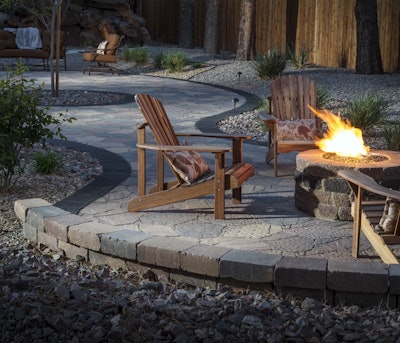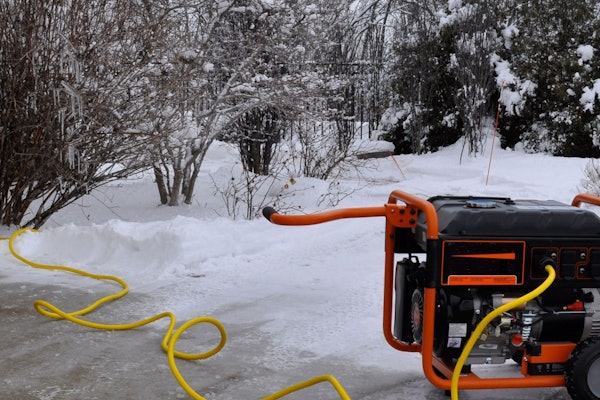 Photo: Belgard
Photo: BelgardIn southwest Florida, there are only three to five evenings a year residents would call cold and about 30 that qualify as cool. Yet the surge in fire pit popularity has reached even this balmy corner of the country.
“It’s not a cold environment, but the demand is still out there,” says Kevin Lynch, owner of Backyard and Beyond in Fort Myers, Florida. “People want the ambiance of sitting around a campfire and talking through the flames.”
The features have also been popular in western Nevada, says Justin La-Fleur, owner of Nevada Landworks in Gardnerville. Previously, his company installed a fire pit here and there. Now eight out of 10 patios the firm constructs now include fire pits, LaFleur says.
“For the enjoyment people are getting out of them, they’re definitely a good value,” he says. The average fire pit Nevada Landworks installs costs $2,000 to $2,500, and LaFleur says homeowners see a return on investment of two and a half to three times that when they sell their property.
Lynch says property owners in his area are turning away from outdoor fireplaces in favor of fire pits, mainly because they produce similar results for less money.
LaFleur says fire pits won’t replace fireplaces, which he calls “a whole different animal,” but at 1⁄10 the cost, fire pits are opening possibilities for homeowners who can’t afford outdoor fireplaces.
Don’t play with fire
Both Lynch and LaFleur say they rarely install wood-burning fire pits. The units use natural gas or propane instead.
“They like the ease of being able to push a button,” Lynch says of his clients. “You get the instant effect – the flame, the beauty – with no ashes or worries about the fire going where it shouldn’t.”
LaFleur says his clients don’t want to buy, chop and carry firewood. And with Nevada’s winds and a highly flammable invasive plant called cheat grass, live embers are a fire hazard. Firewood also attracts beetles and other pests harmful to the landscape, he says.
In the south Florida market, property owners prefer pre-constructed units they can move to a different location during summer. The fire pits Lynch installs weigh 150 to 450 pounds and are made of glass fiber reinforced concrete.
Both contractors hire licensed gas line installers to handle that portion of the job. LaFleur says doing so is in the best interest of all landscapers as mistakes can result in dangerous underground gas leaks. “Fire is not something you want to play around with,” he says.
LaFleur has the installer tap into the home’s existing natural gas or liquid propane line. The units Lynch installs also can be connected to an existing natural gas/propane line or to a propane tank. When using a propane tank, Lynch either buries it or hides it behind a wall or fence.
LaFleur uses cinder blocks and mortar when building a square or rectangular fire pit. For fire pits that are round – the most common shape – he’s found manhole geysers work well.
Eye candy or all-natural?
Clients prefer two distinct fire pit styles, Lynch says. They opt either for a natural setting with an “earthy kind of look” or for a “striking, modern feature” with a tile or granite top.
When his company began building them, almost all fire pits had a natural appearance, LaFleur says. They had a tumbled brick or stone veneer and were filled with lava rock. But now half use colorful fire glass in place of lava rock and eclectic designs have resulted in fire pits that are practically works of art. “You name it, we’ve done it,” he says, recalling wrapping copper around one fire pit and mixing red, green and blue glass with concrete to create a stucco veneer for another.
LaFleur says using colored fire glass is a great way to wake up any landscape. Often patios are made of earth-toned material and the fire pit veneer is the same. LaFleur fills the fire pit with brightly colored fire glass – often cobalt blue or aquamarine because they don’t appear in the landscape – and then decorates the area with urns and other accessories of the same hue. “It takes it to the next level,” he says.
Take cues from the inside of your client’s home when designing a fire pit. If the interior of a client’s home is formal, for instance, LaFleur says he might design a square fire pit with clear or silver fire glass. Because fire pits are often visible from inside the house, you can also pick up hues from the indoor décor. “When you’re inside and look out the window, the first piece of eye candy you see is the fire pit,” LaFleur says.
Mixing fire and water is another twist for the trend. While some fire pits are built beneath waterfalls or are incorporated into a water feature, LaFleur says he tries to persuade his clients just to put fire pits close to water features, so the water will reflect flames. Combining the two features requires a lot of engineering, and if something goes wrong with one, repair can be costly. Sitting next to the fire usually isn’t possible and plants around the water feature could be fire hazards.
A foot in the door
Any landscaper serious about growing his hardscaping business should consider installing fire pits, LaFleur says. Because a fire pit looks bare by itself, building one usually opens avenues for more business. Once you install a fire pit, you need a rug, then pottery, then landscaping, then maybe a patio cover, LaFleur says. Before you know it, a $5,000 job becomes a $20,000 job and “the homeowner is ecstatic,” he says. “It’s just a great way to get your foot in the door and increase your bottom line.”







